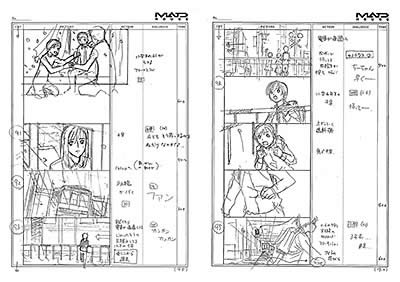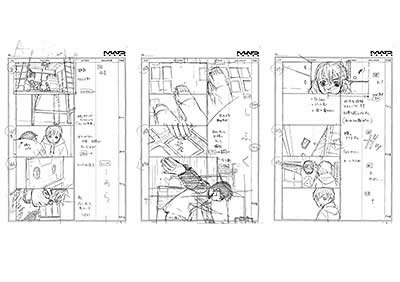- Director, the episode 1 is always the important episode that determines the impression of the entire series. Would you introduce us some of the scenes that you especially put your effort into?
Asaka: First off the animated series takes a different start from the original comic. The comic begins straight from the elementary school arc but the animation begins from the high school arc and then shift back to the elementary school arc. I put some thought in how to show this time shift. It’s one of my favorite scene.
-- This must be the sequence where Chihaya and Taichi are talking on the train and then switches to the flash back.
Asaka: I’ve placed things out so that when high school Chihaya is reminiscing about her childhood on the train, her train passes by young Chihaya. From that point on, the time shifts back to her childhood.
 |
| The above is director Asaka’s favorite sequence where they enter flashback. The time shifts smooth and continuous to surprise the audience. |
|
-- It’s a clever technique used in this sequence. As far as I recall, commonly animation shift into flashback with White In (White screen gradually turn to normal screen) or Overlay (The next picture will fade on to the previous picture). These techniques are used as a common signal to indicate “We’re now entering flashback”…
Asaka: Yes. However in this series the flashback sequence lasts for a while. It begins at episode 1 and ends in episode 4. During those episodes, there is a chance that the viewer will forget that they’re still in a flashback so I wanted to make an impressionable flashback entry and exit. Nailing in the strong impression in episode 1 and make it last till episode 4 when the time comes back.
-- It’s definitely a technique that we don’t see in common series.
Asaka: Yeah. I don’t use it often either.
-- In episode 4, the end of the flashback is indicated by another impression with the cherry blossom petal flowing into the train.
Asaka: During storyboard meeting for episode 4, all I told Tomohiko Ito-san (who’s worked on the storyboard for episode 4) is that we wanted a scene with train and cherry blossom. He did a great job
-- I see. It’s carefully crafted with very austere style. Are there any other scenes that you would like to share with us?
Asaka: Another scene that comes to mind is when Chihaya has her first Karuta match with Arata.
-- That’s definitely a scene of worth.
Asaka: I think that the first idea comes to mind to those who don’t know Karuta, is “Karuta is boring.” Actually Karuta is a sport that can be highly competitive. Karuta is a battle about split second decision/action.
-- When observing real-life competitive Karuta, the player’s hand move so fast it’s difficult to see their movements.
Asaka: In this sequence, it was critical for us to present a cool action. If we couldn’t accomplish this, the series would not have work out. Our challenge is to destroy the audience’s existing image of Karuta. We’ve put quite a bit of effort here.
-- This sequence is also one of Arata’s highlight moments.
Asaka: Arata is a quiet kid that his classmates pick on but when it comes to Karuta, he goes all out. We wanted the audience to be fascinated by Arata like how Chihaya did. This is how we wanted to make an impression of Arata.
-- This must be Gap Moe!
*”Gap Moe” : A certain attraction to a person or character with unexpected characteristic.
Asaka: Ah, yeah… you can call it that.
 |
The first sequence to show Arata playing Karuta.
The actual scenes in the animation are much shorter than indicated on the storyboard. Key animation by Koji Oya, who also serves as animation director for episode 5. |
|
-- Let’s see… in cut 269 it’s noted to shift from normal to slow speed and then in cut 270, the pacing is put back to normal. This scene slows down for a moment and then the speed picks back up when the Karuta is flings out.
Asaka: That’s correct. I’ve directed this way to emphasis on Arata’s skill in precision. This shows Arata’s high potential and also to presents a cool way to connect to the next action. In reality, Arata will reach for the Karuta in a split second so we are using slow motion to show this.
-- This whole sequence is 6 cuts (CUT 266-272) long. That seems like a lot of cuts for a single action.
Asaka: It is. We wanted to use lots of cuts and spend more time than it takes for an actual Karuta movement but still show a fast action impression. However this doesn’t mean we will always use the similar technique through out the entire series. Some Karuta match may end in matter of moments and some may not. This all depends on the situation needs focus on the speed or focus on each moment. Each Karuta action will change according to the situation or the character’s emotion.
-- It’s definitely something to look forward to. Thank you very much for your time today. |